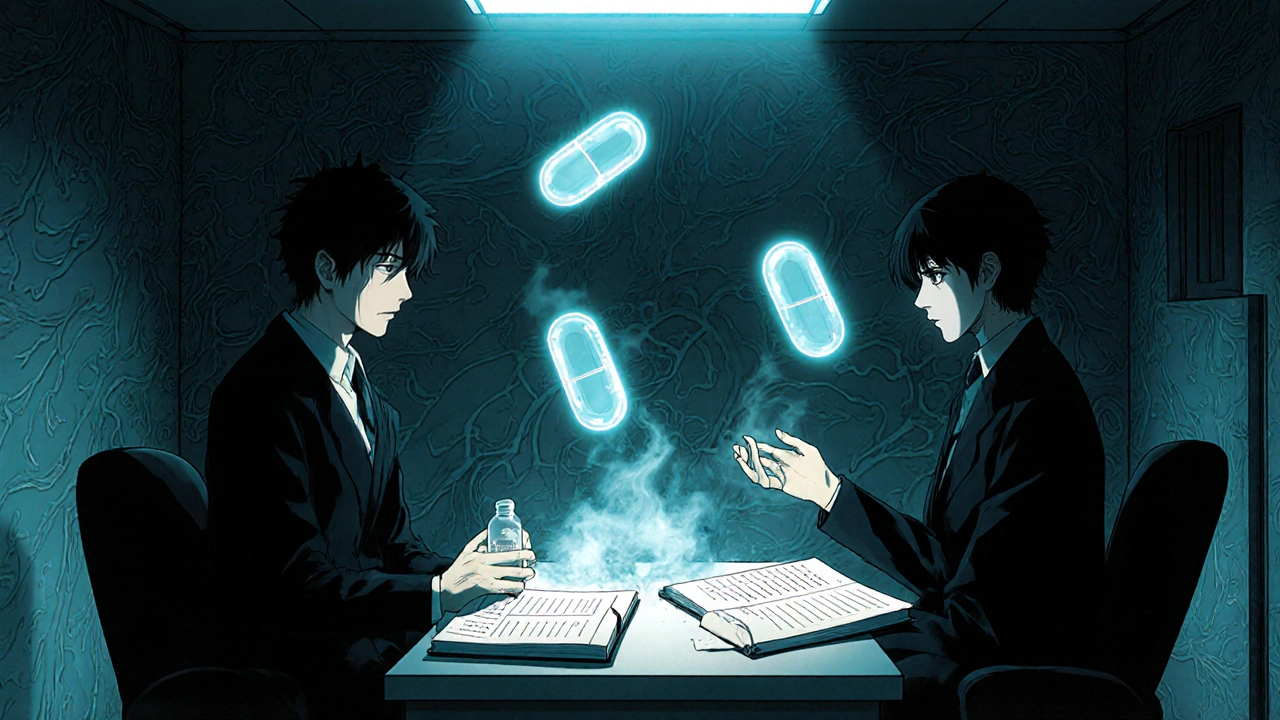Antidepressant Switching Strategy Calculator
Why People Switch Antidepressants
Many people start an antidepressant hoping it will lift their mood, improve sleep, and bring back their energy. But for a lot of them, it doesn’t work the way they expected. About 30 to 50% of people don’t get enough relief from their first medication, according to data from the STAR*D trial. Others start feeling side effects that are hard to live with-like sexual problems, weight gain, nausea, or constant dizziness. These aren’t minor annoyances. They can make someone feel worse than before they started treatment.
When that happens, switching to a different antidepressant becomes the next step. It’s not a failure. It’s part of finding the right treatment. The goal isn’t just to change pills-it’s to find one that works without making life harder. That’s why how you switch matters just as much as which drug you pick.
The Four Ways to Switch Antidepressants
There’s no one-size-fits-all way to switch. Doctors use four main strategies, each with pros and cons depending on your situation.
- Direct switch: Stop the old one and start the new one the next day. This works best when switching between similar drugs, like one SSRI to another, and only if the old drug has a short half-life.
- Cross-taper: Slowly reduce the old medication while slowly increasing the new one over 1 to 2 weeks. This is the most common and safest method for most people.
- Taper and switch: Stop the old medication completely, wait a day, then start the new one. This avoids overlap but can trigger withdrawal symptoms.
- Taper and switch with washout: Stop the old drug, wait weeks before starting the new one. This is only needed when switching from an SSRI or SNRI to an MAOI, or when switching off fluoxetine.
The cross-taper method is usually the best choice. Studies show it cuts withdrawal symptoms by 42% compared to jumping straight to a new drug. It gives your brain time to adjust without a sudden drop in medication levels.
Why Some Antidepressants Are Harder to Switch
Not all antidepressants are created equal when it comes to stopping them. Some leave your system fast. Others stick around for weeks.
Drugs like paroxetine and venlafaxine have very short half-lives-meaning they clear out of your body in hours. If you stop these suddenly, withdrawal symptoms can hit within 24 to 48 hours. Common signs: dizziness, nausea, headaches, “brain zaps” (that electric-shock feeling in your head), and intense anxiety.
On the other hand, fluoxetine (Prozac) is a slow mover. It and its active metabolite can stay in your system for up to six weeks. That means if you’re switching off fluoxetine, you can’t just start a new drug right away. Waiting too soon can cause serotonin syndrome-a dangerous buildup of serotonin that leads to high fever, rapid heartbeat, confusion, muscle stiffness, and even seizures.
That’s why switching from fluoxetine to an MAOI (like phenelzine) requires at least a five-week washout period. The same goes for switching to tricyclics like amitriptyline-fluoxetine blocks how your body breaks them down, which can lead to toxic levels in your blood.

Recognizing Withdrawal vs. Relapse
One of the biggest fears when switching is: “Is this the old depression coming back, or is this just my body adjusting?” The difference matters a lot.
Withdrawal symptoms show up fast-within days of reducing your dose. They include:
- Dizziness (28% of cases)
- Nausea (24%)
- Headaches (22%)
- Insomnia (19%)
- “Brain zaps” (33% with paroxetine)
- Fatigue (18%)
These symptoms get better quickly if you take your old medication again-even just a small dose. They also fade on their own within a week or two.
Relapse symptoms come on slowly-over weeks or months. You feel hopeless again. You lose interest in things you used to enjoy. You sleep too much or too little. You might think about death or suicide. These don’t improve with a quick dose of your old pill. They need real treatment.
If you’re unsure, talk to your doctor. Don’t assume it’s just withdrawal. And don’t ignore new or worsening suicidal thoughts.
How to Make the Switch Safer
Here’s what actually works to reduce side effects during a switch:
- Go slow. Tapering over 2 to 4 weeks is standard. For sensitive people, stretching it to 6 or 8 weeks cuts symptoms dramatically.
- Use liquid formulations. If your pill doesn’t come in a low dose, ask about liquid versions. They let you make tiny adjustments-like reducing by 5% instead of 25%.
- Don’t skip meals. Taking your new medication with food reduces nausea by about 35%, according to Mayo Clinic data. Eat small, frequent meals. Suck on sugar-free hard candy if your mouth feels dry or weird.
- Stay hydrated. Drink water throughout the day. Dehydration makes dizziness and fatigue worse.
- Don’t stop cold turkey. Except for fluoxetine, every antidepressant needs a gradual taper. Even if you’ve been on it for only 4 weeks, stopping suddenly can cause serious withdrawal.
Some people find temporary help from low-dose hydroxyzine for anxiety or sleep. Others use melatonin for insomnia. But always check with your doctor before adding anything-even over-the-counter stuff.

What to Expect After Starting the New Medication
Just because you’ve switched doesn’t mean you’ll feel better right away. The new antidepressant can take 4 to 6 weeks to build up in your system and start working. In the meantime, you might feel worse before you feel better.
That’s why follow-up is critical. Most guidelines recommend seeing your doctor within 2 weeks of starting the new drug. If you’re under 25 or have thoughts of self-harm, you need to be checked within 7 days and again by day 28.
Keep a simple journal: rate your mood each day (1 to 10), note side effects, and track sleep and appetite. Bring it to your appointment. It helps your doctor see patterns you might miss.
When to Consider Testing Before Switching
Some people wonder if genetic testing can help pick the right antidepressant. Tests like GeneSight analyze how your body metabolizes drugs. In the 2022 GUIDED II trial, people who used the test had 28% higher remission rates.
But here’s the catch: it costs around $399 out-of-pocket in the U.S., and insurance doesn’t always cover it. In Australia, it’s not yet widely available through the public system. It’s a useful tool-but not a magic solution. It’s best for people who’ve tried multiple meds without success.
The Bottom Line
Switching antidepressants isn’t a quick fix. It’s a careful process that requires patience, planning, and good communication with your doctor. The goal isn’t just to change pills-it’s to find a treatment that lets you live your life without being weighed down by side effects.
Most people who switch with a structured plan-especially cross-tapering-do better than those who stop and start cold. Education helps too. One UK study found that patients who knew what to expect had 37% fewer unnecessary stops in their treatment.
If you’re thinking about switching, don’t do it alone. Talk to your doctor. Ask about your options. Share your fears. Bring up your side effects. Your mental health matters more than sticking to a script. And if one drug doesn’t work, that doesn’t mean you’re broken. It just means you haven’t found the right one yet.
Can I switch antidepressants on my own?
No. Switching antidepressants without medical supervision can be dangerous. Stopping suddenly can cause withdrawal symptoms like brain zaps, severe anxiety, or even seizures. Starting a new drug too soon-especially after fluoxetine or MAOIs-can trigger serotonin syndrome, a life-threatening condition. Always work with your doctor to plan a safe transition.
How long do withdrawal symptoms last after switching?
Most withdrawal symptoms start within 1 to 7 days after reducing your dose and last 1 to 2 weeks. For drugs with longer half-lives like fluoxetine, symptoms may be delayed and last longer. If symptoms persist beyond 3 weeks or get worse, contact your doctor-it could be relapse or another issue.
Is it normal to feel worse after switching?
Yes, temporarily. Your brain is adjusting to a new chemical balance. You might feel more anxious, tired, or emotionally flat for the first 1 to 2 weeks. But if you’re feeling significantly worse after 3 weeks, or if you have new suicidal thoughts, tell your doctor immediately. It’s not normal to feel worse long-term.
What’s the safest antidepressant to switch to?
There’s no single “safest” antidepressant. Safety depends on your history, side effects, and other medications. For example, if you had sexual side effects on an SSRI, vortioxetine or bupropion might be better options. If weight gain was an issue, bupropion or fluoxetine are less likely to cause it. Your doctor will match the new drug to your specific needs.
Can I use alcohol while switching antidepressants?
It’s best to avoid alcohol during a switch. Alcohol can worsen depression, interfere with how antidepressants work, and increase side effects like dizziness, drowsiness, and nausea. It can also raise your risk of serotonin syndrome when combined with certain drugs. Wait until you’re stable on the new medication before considering alcohol again.
How do I know if I need to switch again?
If after 6 to 8 weeks on the new medication you still have significant depression symptoms or intolerable side effects, it may be time to consider another switch. Keep track of your progress with a mood journal. If you’re not improving-or if side effects are worse than your original symptoms-talk to your doctor about alternatives like therapy, lifestyle changes, or different medication classes.


Megan Raines
October 30, 2025 AT 14:34Vishwajeet Gade
October 31, 2025 AT 01:54Mamadou Seck
November 1, 2025 AT 05:13Wayne Keller
November 2, 2025 AT 05:26California Daughter
November 3, 2025 AT 00:16Shana Labed
November 4, 2025 AT 18:24Judy Schumacher
November 5, 2025 AT 11:44Anthony Griek
November 6, 2025 AT 13:44Norman Rexford
November 7, 2025 AT 10:20